IDIOSINCRASIA
the fallas, A FESTIVAL DECLARED INTANGIBLE HERITAGE OF HUMMANITY BY UNESCO IS CELEBRATED IN MANY CITIES THROUGHOUT THE VALENCIAN COMMUNITY.
However, each town has its own peculiarities and in the case of Gandia, the Fallas festival has its own character and particularities that make it unique. Different events that take place exclusively in the city make the Fallas of Gandia a celebration with a particular idiosyncrasy. These are just a few examples:
falleras presentations:
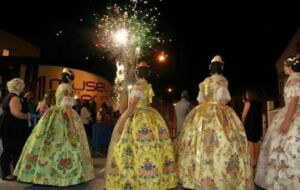 The presentations of the highest representatives of the festival in the city, the Falleras Mayores de Gandia, as well as those of the representatives of each of the twenty-three falleras commissions, which in this city are called Queens (another of the peculiarities), are important events in the festive calendar, kicking off the fallero year.
The presentations of the highest representatives of the festival in the city, the Falleras Mayores de Gandia, as well as those of the representatives of each of the twenty-three falleras commissions, which in this city are called Queens (another of the peculiarities), are important events in the festive calendar, kicking off the fallero year.
Once the requests for the Major Fallas of Gandia, adult and child, are made around the month of July, the well-known demanàs, and with the presentations of these in October, the presentations of the Queens of each falla begin, occupying practically all the weekends and holidays from October to February, approximately.
The building of the Museu Faller de Gandia, which has an auditorium with a capacity for 574 people (484 people seated on the ground floor, plus 90 people seated on the first floor) is where all the presentations take place, which become a spectacle for those who come to see them.
Here you can appreciate the importance of the Fallas ritual, its protocol, its declamation in Valencian, with the intervention of people who are in charge of presenting the event, as well as of maintainers who focus on praising the prestige and greatness of the festival and of the representatives who take office; events in which we can observe the richness of the traditional costumes, with clothes that are usually brand new for this important day, and with fireworks shows that complete the composition of the event.
All these events involve a logistical preparation that involves a large number of economic sectors: from the assembly of all the scenery, the sound and light technicians, decoration and floristry, hairdressing, clothing and clothing, catering for the meal that is usually offered after the event, the cleaning of the venue, before and after, and the staff responsible for the opening and closing of the space, access control and the building itself during the development of the presentations.
All of this demonstrates the multitude of people and businesses involved in a single event of the Federació de Falles or Fallas, whose impact is multiplied by the fact that the particular events of the twenty-three Fallas commissions of the Federation are often replicated.
 The participation of the commissions is massive in these events, attended by a multitude of people from inside and outside the commissions themselves, as well as local authorities and sponsoring companies, especially highlighting the presentations of the Falleras Mayores of the city, as it is an event that is broadcast live on one of the two local televisions.
The participation of the commissions is massive in these events, attended by a multitude of people from inside and outside the commissions themselves, as well as local authorities and sponsoring companies, especially highlighting the presentations of the Falleras Mayores of the city, as it is an event that is broadcast live on one of the two local televisions.
An average of four hundred people pass through the building at each of these events, a figure that increases especially in commissions where there are a considerable number of falleros and falleras, or when specific anniversaries are celebrated, such as anniversaries of the constitution of the corresponding fallera association, which means that more people gather. This could be seen in the 2021-2022 financial year, when the Federació de Falles celebrated the 75th anniversary of the constitution of the Junta Local Fallera.
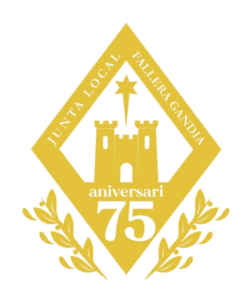
“ninot indultat” and “ninots” exhibition:
One of the events that has the greatest impact on the tourist spectrum, with a large number of visitors, is the “Ninot” exhibition, from which the “Ninot Indultat” will later emerge, which refers to the Ninot that is “pardoned”, which is saved from the flames of the purifying fire of the 19th March, being specifically two which are saved, one chosen from among the Ninots presented by the adult commissions and the other from among those offered to the exhibition by the children’s commissions, which make up the Federació de Falles de Gandia (Federation of Gandia’s Falles).
This exhibition is made up, therefore, of the two ninots that each falla brings to the exhibition, one from the children’s monument and the other from the adults’ monument, which will later be included in the fallas that will be planted in March in the streets and squares of Gandia; from among them, and according to the different categories of monument existing in the city, two ninots are chosen per section, one adult and one child. Subsequently, a jury will determine the two ninots indultats, one adult and one child, for each fallero year.
It will be in March when it will be revealed which Ninot mayor and which Ninot infantil will be awarded the Ninots Indultats of the year, chosen from among the finalists.
The figure or Ninot that is saved from the fire is chosen for its technical characteristics, originality, ingenuity and criticism. This exhibition is held in the exhibition hall of the Casa de la Cultura de Gandia, in the heart of the city centre.
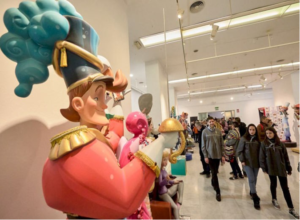 From the end of February and the beginning of March, these masterpieces are on display for about a week; there are forty-six in total, as we have already mentioned, twenty-three major ones and twenty-three children’s ones, of which only two will be saved, which will be kept in the permanent exhibition of the city’s Museu Faller (Faller Museum).
From the end of February and the beginning of March, these masterpieces are on display for about a week; there are forty-six in total, as we have already mentioned, twenty-three major ones and twenty-three children’s ones, of which only two will be saved, which will be kept in the permanent exhibition of the city’s Museu Faller (Faller Museum).
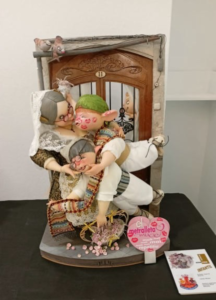 The first pardon was made in 1935 and, since then, with the parenthesis of the civil war, the corresponding scene of each year has never ceased to be saved, taking into account that the celebrations of the year 2020 were moved, due to the Covid-19 pandemic, to September of the year 2021, so that the pardoned ones belonged to 2020-2021.
The first pardon was made in 1935 and, since then, with the parenthesis of the civil war, the corresponding scene of each year has never ceased to be saved, taking into account that the celebrations of the year 2020 were moved, due to the Covid-19 pandemic, to September of the year 2021, so that the pardoned ones belonged to 2020-2021.
In addition, this exhibition gives us a first glimpse of what will be the Fallas monument, both major and children’s, that each commission will plant in March, which can be read from two points of view: from the point of view of the fallas lovers, falleros and falleras, because of their interest in having the different monuments of each commission revealed, as a sample of what will be the quality and theme of each falla; and from the perspective of the tourists who, if they cannot be present at the Fallas festivities, will be able to get an idea of what a ninot is and how it makes up the artistic and monumental work that represents the falla; as well as an attraction for them to visit us.
children’s music festival:
The Museu Faller de Gandia hosts every year the Children’s Music Festival, now in its 32nd edition and organised by the Federació de Falles de Gandia. Nearly five hundred children offered the audience their magnificent skills in dance and interpretation. Due to the high participation, the Festival is held in four sessions, 10:30 am, 12:30 pm, 4:30 pm and 6:30 pm.
This event is usually held between November and December and, due to the importance it has acquired over the years, the organisation has had to structure it, for several editions now, in different sessions to accommodate the public.
There is a full house at the different shows, with a total of around eighteen hundred people between spectators and artists using the Museum’s theatre.
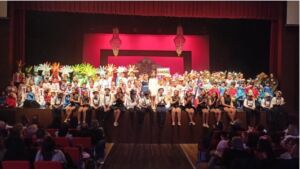 The girls and boys of the fallas perform to a musical background against which they project a choreography, all accompanied by ingenious and elaborate costumes, made by the falleras and falleros themselves, resulting in an impressive show, which is broadcast live on local television. The level of professionalism is so high that some commissions have even taken their dances to national television.
The girls and boys of the fallas perform to a musical background against which they project a choreography, all accompanied by ingenious and elaborate costumes, made by the falleras and falleros themselves, resulting in an impressive show, which is broadcast live on local television. The level of professionalism is so high that some commissions have even taken their dances to national television.
For some years now, each of the sessions has been closed with a performance by the Fallera Major Infantil of Gandia and the boys and girls of her Court of Honour or Cort d’Honor. In addition, the children’s representative is in charge of presenting the event.
fallera parade:
It is one of the most massive events outside the Fallas days in March. Traditionally, two Fallas parades had been held, one for adults and one for children, but due to the enormous work and dedication that each one required, a few years ago it was decided to combine adults and children in a single parade, obtaining a great result in terms of participation of people, public and visual beauty, coinciding, moreover, with the carnival season.
 The twenty-three commissions parade through the central streets of the city with impressive costumes, made by the falleros and falleras themselves, structured in comparsas and, many times, using floats to transport the queens of each falla and varied music, as well as lights to appreciate the work done when it gets dark in the evening. The queens are accompanied by band music, carrying their fabulous and elaborate bouquets of flowers, being one of the events in which the florists are most innovative in their tailoring, as well as wearing traditional Valencian clothing and hair styled in the style of fallera or valenciana, depending on the costume they are wearing.
The twenty-three commissions parade through the central streets of the city with impressive costumes, made by the falleros and falleras themselves, structured in comparsas and, many times, using floats to transport the queens of each falla and varied music, as well as lights to appreciate the work done when it gets dark in the evening. The queens are accompanied by band music, carrying their fabulous and elaborate bouquets of flowers, being one of the events in which the florists are most innovative in their tailoring, as well as wearing traditional Valencian clothing and hair styled in the style of fallera or valenciana, depending on the costume they are wearing.
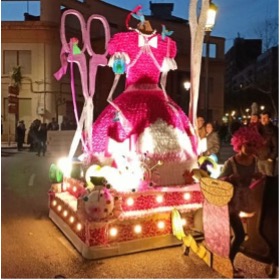 Each of the fallera associations chooses a theme and develops it using the fallera criticism that is so characteristic of the festival, pointing to all the current news and burning issues in society at the time, travelling through the main arteries of the centre, crowded with people, from 17:00 hours until 22:00, well into the night.
Each of the fallera associations chooses a theme and develops it using the fallera criticism that is so characteristic of the festival, pointing to all the current news and burning issues in society at the time, travelling through the main arteries of the centre, crowded with people, from 17:00 hours until 22:00, well into the night.
The duration is variable, depending on the number of participants of each commission each year, but always ensuring thousands of people along the route. It is an event open to everyone in which you can appreciate the meticulous and constant work of the commissions, making incredible structures and costumes.
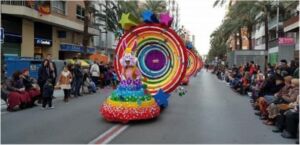 In addition to the accompaniment of the marching bands for the queens of each commission, and the music that is played through loudspeakers to encourage each comparsa, the falleras and falleros usually prepare choreographies that contribute to embellish and animate the parade, which is much applauded by the general public.
In addition to the accompaniment of the marching bands for the queens of each commission, and the music that is played through loudspeakers to encourage each comparsa, the falleras and falleros usually prepare choreographies that contribute to embellish and animate the parade, which is much applauded by the general public.
Prizes are given to the comparsas and the parade as a whole, rewarding the work of each fallera commission, which are distributed in the Plaza Mayor of Gandia during the Fallas, specifically, on the 16th of March, after the act of baptism or bateig.
Albaes:
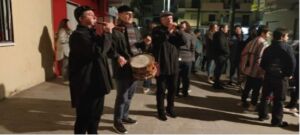 One of the most representative Valencian manifestations and of the Fallas of Gandia in particular, as they are deeply rooted among the commissions, are the albaes.
One of the most representative Valencian manifestations and of the Fallas of Gandia in particular, as they are deeply rooted among the commissions, are the albaes.
According to the Dictionary of the Royal Academy of the Spanish Language, the word albada or alborada refers to a poetic or musical composition, as well as music played at dawn and in the open air. The word also refers to the time that elapses from dawn to sunrise. Thus, we can define les albaes as that poetic composition, of popular origin, which expresses and exalts feelings related to each of the queens of the commission and their respective families, their hopes for the fallero year and their desires in the fallero sphere or in their personal lives, highlighting personal aspects of those who receive the appreciated song.
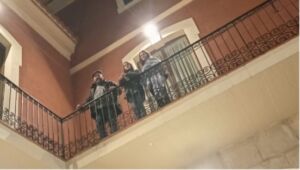 It is, therefore, a piece of popular Valencian music, of a vocal nature, with lyrics improvised by a versador (versador) or versadora (versadora) who narrates some words to the ear of a cantaor or cantaora (singer), These are performed at night or in the early hours of the morning in front of the house of someone who is to be honoured, as we have already said, the queens, adults and children, of each commission, as well as the children’s president.
It is, therefore, a piece of popular Valencian music, of a vocal nature, with lyrics improvised by a versador (versador) or versadora (versadora) who narrates some words to the ear of a cantaor or cantaora (singer), These are performed at night or in the early hours of the morning in front of the house of someone who is to be honoured, as we have already said, the queens, adults and children, of each commission, as well as the children’s president.
About a month and a half before the Fallas week in March, each of the twenty-three commissions organise the so-called nit de les albaes, with many of them also singing for the city’s Falleras Mayores, who receive the falleros and falleras at their headquarters in the Casa de la Cultura. Wearing the typical fallero blouse and with the scarf identifying each commission around their necks, and sometimes even dressed in the traditional fallera costume, a procession of falleros and falleras, together with the people in charge of versing and singing, as well as the musicians who play the tabal and dolçaina, go out through the fallera neighbourhood or demarcation with joy and jubilation, ready to sing albaes to their fallera queens and to the Falleras Mayores of the city. The albà is part of the cant d’estil valencià, musical compositions with an original structure that only occur in this part of the state.
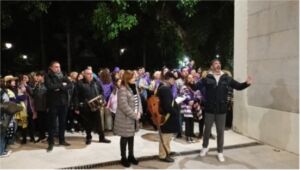 The whole procession stands in front of the house of the person being honoured, as in the case of the Fallas Queen, who goes out onto the balcony or to the window and the procession sings popular songs, sometimes accompanied by traditional dances, until everyone falls silent so that the albà can begin.
The whole procession stands in front of the house of the person being honoured, as in the case of the Fallas Queen, who goes out onto the balcony or to the window and the procession sings popular songs, sometimes accompanied by traditional dances, until everyone falls silent so that the albà can begin.
The person who sings has previously been in charge of finding out about the recipient of the songs and her family, and in this way has made personalised verses for her, sometimes satirical, which makes the audience laugh, and sometimes affectionate, which are rewarded with tears of emotion and applause from the audience. The singers do not know what they are going to sing until the first verses are recited in their ears, and then the cantaors and cantaores begin to sing them, linking the other verses as the versaor or versaora recites them, and all this without stopping singing. It is a song of great complexity, close to the bravura of the Aragonese jota and a cappella, in which the singers’ breaks are filled with a musical structure that is repeated in the staging, performed by the dolçaina and tabalet.
The procession goes through various streets of the neighbourhood singing in each of the houses of their falleras queens or in the houses of the festive associations, and many of the commissions also come to entertain the Falleras Mayores de Gandia, the President or President of the Federation and the companion of the Fallera Mayor Infantil, an event which, as we have already said, takes place in the Casa de la Cultura, which becomes the house of the Federació de Falles when these dates of albaes arrive and until after the Fallas of March.
It should be noted that many fallas hire qualified singers, professionals of the cant d’estil valencià, such as Christian Penalba, in the picture above, Pep Gimeno “Botifarra” or La Maria, among many other voices, which bring greater prestige to the event, motivating people from other fallas committees to come and see these people sing, Moreover, it gives value to these personalities of our Valencian music and of the Catalan, Balearic, Valencian and even Aragonese speaking areas, as they are well-known voices beyond our borders, as many of these people give concerts in Catalonia, the Balearic Islands, Castile-La Mancha, Aragon, and even in Morocco.
After the singing of the albà, an agape is usually offered in each house of the queen or casal to thank the fallaeros and falleras for their attendance, as well as the group of musicians, tabaleters/res and dolçainers/res, singers, cantaors and cantaores, and versadores and versadoras.
Thus, groups of falleros and falleras gather in front of the houses, in each of the neighbourhoods, ready to spend a pleasant evening of laughter and emotions, with traditional songs and Valencian music, in company and brotherhood, and where you can enjoy delicacies typical of our land, It must be said that the famous Valencian “putxero” is often prepared, horchata and other sweets, food and drinks typical of Gandia and our region are served, which means that the local food and catering sector is called upon to supply the large number of tables that are set up for the event.
short films festival:
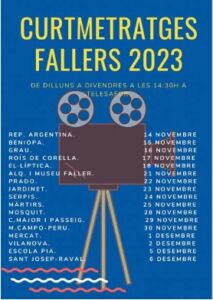 Year after year, the Fallas of Gandia organise the great gala of the Fallas short films, curtmetratges fallers in Valencian, as well as the presentation of the Fede Awards, abbreviation of the word Federació, as the event is organised by the Federació de Falles de Gandia, and is also broadcast live on local television from the Museu Faller. The gala usually starts at 21:00 hours.
Year after year, the Fallas of Gandia organise the great gala of the Fallas short films, curtmetratges fallers in Valencian, as well as the presentation of the Fede Awards, abbreviation of the word Federació, as the event is organised by the Federació de Falles de Gandia, and is also broadcast live on local television from the Museu Faller. The gala usually starts at 21:00 hours.
In this event the winners of the FEDE awards, who have been previously nominated by a jury chosen for this purpose, are announced. It is usually held towards the end of January and beginning of February and a few minutes of the different short films presented by each commission are shown, although by the time the gala is held, all of them have already been broadcast in full on local television, according to a schedule that is announced, so that the public can be aware of them and can watch them to make a value judgement by the time the awards ceremony is held.
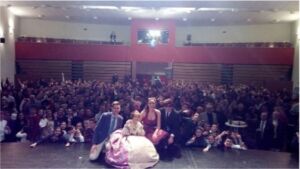 The many months of work and dedication of all the members of the committee are reflected in the quality of the films, which improve year after year, incorporating the latest innovations, techniques and fashions. In fact, we can cite as an example the short film of the Falla Plaça Exèrcit Espanyol-Jardinet, which was subtitled and used sign language, thus promoting the social integration of deaf people, so that, once again, the Fallas of Gandia contribute to advance and take firm steps in favour of inclusion. Apart from the fact that the commissions generally resort to themes that they analyse from the point of view of social criticism, to denounce injustices, to praise the good qualities of people and towns, beyond making humour about political and city issues, which are also recurrent.
The many months of work and dedication of all the members of the committee are reflected in the quality of the films, which improve year after year, incorporating the latest innovations, techniques and fashions. In fact, we can cite as an example the short film of the Falla Plaça Exèrcit Espanyol-Jardinet, which was subtitled and used sign language, thus promoting the social integration of deaf people, so that, once again, the Fallas of Gandia contribute to advance and take firm steps in favour of inclusion. Apart from the fact that the commissions generally resort to themes that they analyse from the point of view of social criticism, to denounce injustices, to praise the good qualities of people and towns, beyond making humour about political and city issues, which are also recurrent.
It should not be forgotten that organising the gala also requires the collaboration and hiring of qualified personnel and companies to take charge of the set, technical means and the intervention of local television, again mobilising different businesses in the city, in this case, entertainment companies.
In addition, a well-known person from the world of humour is usually invited to make interventions during the gala, in order to make the public’s attendance more enjoyable and as an added incentive to attend a fantastic evening of culture and creativity, in which there is real expectation to see who will win the desired “statuette”, acquiring a very dignified appearance and staging, similar to the Goya Gala of the Spanish cinema. This can be seen in the attire and dress of the attendees, who are full of wit, elegance and humour when wearing their costumes and dresses chosen for the occasion.
Ligorio Ferrer theatre exhibition:
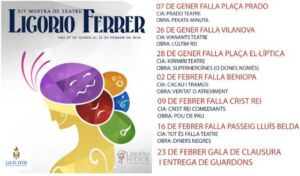 Another event that occupies a large part of the Fallas Federation of Gandia’s programme is the Ligorio Ferrer Theatre Exhibition, the name given to the event in homage to the first president of the Junta Local Fallera of Gandia.
Another event that occupies a large part of the Fallas Federation of Gandia’s programme is the Ligorio Ferrer Theatre Exhibition, the name given to the event in homage to the first president of the Junta Local Fallera of Gandia.
Ligorio Ferrer (Gandia 1898-1958) was one of the actors and theatre directors of Gandia who achieved more recognition and fame in the beginnings of the Fallas in Gandia, thanks to his journalistic facet, in whose chronicles he narrated everything about the theatre of Gandia and the region of La Safor, of which the ducal city is the capital.
The Amateur Theatre Festival of Gandia Ligorio Ferrer, which is its full name, is organised by the Federation of Fallas of Gandia every year, being the one celebrated in the present year 2023 the XVII31 edition, counting this year with the participation of eight theatre groups of the Fallas commissions of Gandia.
All the plays are performed in the framework of the Festival at the Museu Faller de Gandia; once all the companies have performed on the stage of the Museu’s theatre, a gala closing ceremony is held, with a play by a professional and well-known theatre company from the region as the finishing touch. Afterwards, the awards are presented by the jury for best actor, best actress, best staging, best supporting actor and actress, best new actor and actress and best direction.
 This is yet another example of the fact that the Fallas of Gandia, in addition to the festival, are based on a strong commitment to Valencian culture and language, as these theatrical performances are in Valencian, thus promoting the co-official language which, together with Spanish, forms part of the languages of the Spanish heritage, in compliance with the constitutional mandate that orders that they be the object of special respect and protection.
This is yet another example of the fact that the Fallas of Gandia, in addition to the festival, are based on a strong commitment to Valencian culture and language, as these theatrical performances are in Valencian, thus promoting the co-official language which, together with Spanish, forms part of the languages of the Spanish heritage, in compliance with the constitutional mandate that orders that they be the object of special respect and protection.
In fact, we can verify the long history of the theatrical tradition in the Safor and in the fallas of the city of Gandia by analysing the book “El teatro en la Safor. 1939-2000”, by the writer and theatre director Josep Enric Gonga, an activity that has been continued with the contribution that the fallas have made with the amateur theatre groups, which have managed to attract a large audience to each performance at the Museu Faller de Gandia.
In fact, the Museum’s theatre, with a capacity for some six hundred seats, practically sells out, taking into account that, in some cases, the plays continue to be performed in towns in the region and even beyond. All these performances are open to anyone and are part of the cultural programme of the Museu Faller de Gandia building.
fallas broadcasts and radio news:
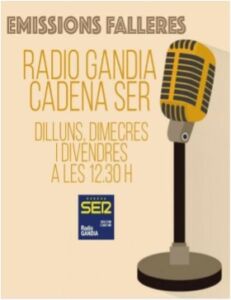 Another of the bets of the falleras associations of Gandia and the Federació de Falles is to use the radio medium. By means of a previous script with an acid and critical character, some members of each commission are going to record their own radio broadcasts (the first one dates back to 1947) and news programmes, which talk about the fallero collective and society in general.
Another of the bets of the falleras associations of Gandia and the Federació de Falles is to use the radio medium. By means of a previous script with an acid and critical character, some members of each commission are going to record their own radio broadcasts (the first one dates back to 1947) and news programmes, which talk about the fallero collective and society in general.
Many of them bring current issues to the forefront and discuss aspects of the fiesta or the city in general, in many cases criticising well-known personalities and the city’s political class.
As a result of the work carried out by the commissions in the Fallas broadcasts and news programmes, sponsored respectively by Cadena SER-Gandia and Onda Naranja Cope-Gandia, the commissions receive awards from the promoters, which encourages participation in each edition.
proclamation, speech and gala dance:
When the day of the Pregó, the Crida Fallera and the Ball de Gala arrives, that is to say, the proclamation, the invocation to the festival and the Gala Ball in Spanish, we can say that well-known and unanimously recognised phrase in the Fallas world of “ja estem en falles”, “we are already in Fallas”. This is the moment when the Fallas festival kicks off, according to the general feeling, as the different Fallas associations of the city take to the streets, despite the February cold, and invade every corner of their neighbourhoods with their costumes and band music, in an event that is divided into three parts, as the title itself announces.
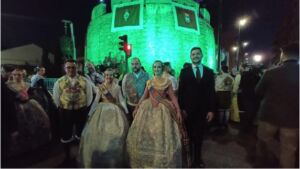 Thus, the first of the events begins at dusk, with the Pregó, that is to say, a person with roots in the city, the fallas, or all of these combined, is chosen by the Federation to deliver a speech based on announcing the imminent arrival of the fallera festival and encouraging the public to participate in it, declaiming proclamations and praises about it.
Thus, the first of the events begins at dusk, with the Pregó, that is to say, a person with roots in the city, the fallas, or all of these combined, is chosen by the Federation to deliver a speech based on announcing the imminent arrival of the fallera festival and encouraging the public to participate in it, declaiming proclamations and praises about it.
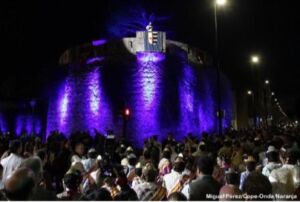 Traditionally it was held in the Plaza Mayor of the city of Gandia, with attempts to decentralise the event in the neighbourhoods, as when it took place in the Plaza de Benipeixcar (named after the former independent village, annexed to Gandia in 1965), in 2012, and in recent years the Torreón del Pino or Torrelló del Pi has been used, a historical monument of the city that forms part of the extension of the 16th century wall, which provides an incomparable setting for this event, from where the personality chosen for his or her professional or festive merits and linked to Valencian tradition makes the pregó, addressing the falleros and falleras and the citizens in general.
Traditionally it was held in the Plaza Mayor of the city of Gandia, with attempts to decentralise the event in the neighbourhoods, as when it took place in the Plaza de Benipeixcar (named after the former independent village, annexed to Gandia in 1965), in 2012, and in recent years the Torreón del Pino or Torrelló del Pi has been used, a historical monument of the city that forms part of the extension of the 16th century wall, which provides an incomparable setting for this event, from where the personality chosen for his or her professional or festive merits and linked to Valencian tradition makes the pregó, addressing the falleros and falleras and the citizens in general.
The Pregó has incorporated novelties over the years, such as the initial route from the Plaza del Prado of the city, where all the Queens and Presidents of the Fallas of Gandia, adults and children, together with the authorities and the fallera retinue, led by the Falleras Mayores of Gandia and the pregonero or pregonera himself, who to the sound of the tabal and the dolçaina go to the foot of the Torreón. Or the incorporation of a sign language interpreter, so that deaf people can follow.
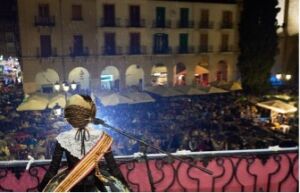 After the Pregó, the whole crowd moves to the town hall square, the Plaça Major, where from the balcony of the town hall, the Fallera Mayor and the Fallera Mayor Infantil of Gandia make the Crida, that is, an appeal to the whole of Gandia society and the fallero collective to enjoy and participate in the days of fallas, which are very close to these dates.
After the Pregó, the whole crowd moves to the town hall square, the Plaça Major, where from the balcony of the town hall, the Fallera Mayor and the Fallera Mayor Infantil of Gandia make the Crida, that is, an appeal to the whole of Gandia society and the fallero collective to enjoy and participate in the days of fallas, which are very close to these dates.
This is the most awaited moment, because the falleros and falleras of Gandia want to see their highest representatives, the Falleras Mayores of the city, they want to hear their voices encouraging and promoting joy, fun and participation in the Fallas of the year already underway. And hardly anything or anyone will stop them in their efforts; thus, in the images above and below we can see the Falleras Mayores of Gandia 2022 encouraging the audience, who were unperturbed despite it was raining at the time.
 After the speeches of the Falleras Mayores of Gandia, the Mayor of Gandia dedicates a few words to the Fallas collective and to the whole of the citizenship that is situated in the Plaza Mayor, with the same purpose of inviting to the party, to the responsibility, to the brotherhood, putting in value all the attributes of the Fallas festival and the capacities of the falleros and falleras demonstrated in the different acts of the calendar.
After the speeches of the Falleras Mayores of Gandia, the Mayor of Gandia dedicates a few words to the Fallas collective and to the whole of the citizenship that is situated in the Plaza Mayor, with the same purpose of inviting to the party, to the responsibility, to the brotherhood, putting in value all the attributes of the Fallas festival and the capacities of the falleros and falleras demonstrated in the different acts of the calendar.
After the acts of the Pregó and the Crida, each fallera association goes to their houses to have dinner in fellowship, all together falleros and falleras, and at twelve o’clock at night, punctually, the Falla Queens of each adult fallera commission, together with their Presidents, must be at the place where the Gala Ball will be held in honour of the Fallas Major of Gandia of the year.
It is a dance in homage to the Fallera Mayor of Gandia, who opens this event dancing with the mayor or councillor delegate of Fallas, which is joined by the falleras components of the Court of Honour and their respective companions, as well as the rest of the people who come to the event. This dance has had several locations, the last one being the hall set up for this purpose in the Museu Faller de Gandia. As the name suggests, it is a gala ball, which should be attended mainly in Fallas or Valencian costume, although it is also possible to attend in street clothes suitable for the moment of distinction that it entails.
It is a multitudinous act, of great emotion, in which the city merges with the Fallas festival, as people from all areas and sectors of the city attend at the call and invitation of the Fallas Federation. Let’s say that the Fallera Mayor Infantil has her own act in the Festival Musical Infantil and the Fallera Mayor Adulta has this dance of veneration and respect, which begins with a waltz and ends with the best known and most popular songs of the moment.
The Fallera Mayor Infantil at the Crida of 2023, after addressing the audience, with her uncle. Below, the Falleras Mayores being interviewed by a television journalist.
exhibition of fallas books of the valencian community
It is already known the importance that culture and literature represent in the world of the Fallas, with excellent literary works reflected in the explanatory books of each Fallas monument, the llibrets, where the main theme is analysed from a critical perspective, and other accessory themes, which the Fallas includes in the specific Fallas exercise.
 Thus, the Associació d’Estudis Fallers, the Federació de Falles de Gandia and the City Council of Gandia organise the Mostra de Llibrets de la Comunitat Valenciana in the Museu Faller of the city. This activity is normally planned for the month of April or May and in it we can find a sample of the best examples of the Fallas of the Comunitat, becoming also a space for dialogue to exchange proposals and to give thematic talks that are organised to solve problems and give ideas in this section so important for our festival.
Thus, the Associació d’Estudis Fallers, the Federació de Falles de Gandia and the City Council of Gandia organise the Mostra de Llibrets de la Comunitat Valenciana in the Museu Faller of the city. This activity is normally planned for the month of April or May and in it we can find a sample of the best examples of the Fallas of the Comunitat, becoming also a space for dialogue to exchange proposals and to give thematic talks that are organised to solve problems and give ideas in this section so important for our festival.
The speakers are selected in relation to the topics to be dealt with and it becomes a fundamental space for the sharing of transversal opinions, which encompass the different commissions, with issues such as funding for publication, new design techniques or the regulations to be able to publish the llibrets.
In addition, in this Mostra our flagship of letters, the book of the Fallas of Gandia, called, as we have already mentioned, Foc i Flama, has a spectacular reception. It is a compendium or almanac made up of the most important Fallas information of each of the Fallas commissions of the city, with first class photographic work and bound in a high quality format, which makes it a very desirable book in the world of Fallas.
It is important to emphasize that the commissions that participate in the exhibition donate a copy of their works, which become part of the Documentation Centre of the Museu Faller de Gandia, which we will talk about later on.
Returning to the Foc i Flama, it is a complete book that contains the sketches of each Fallas commission of the city, the different positions of the executives of the Fallas cultural associations, in some occasions it has included the budgets of each Falla, the categories in which each monument competes, the photographs of the presidents and presidents, adults and children, the queens of the different Fallas, There is also a monograph on topics of interest to the festival or to society, interesting articles by prestigious writers, as well as a summary of the prizes awarded in the previous year and the awards given by the highest body that governs the festival to the falleros and falleras of the different commissions.
At this point, it is also worth mentioning the Pepito, a magazine-like publication that takes its name from San José and makes it diminutive and familiar, in which the most immediate news about the Fallas of the year is collected, such as the Fallas presentations, the Musical Festival, the parades, together with opinion articles and photographs of the different events.
joint reading of the “tirant lo blanc”
As with the continuous reading of Don Quixote de la Mancha, carried out at the Círculo de Bellas Artes in Madrid, the falleros and falleras of Gandia wish to praise one of the most important books of universal literature, essential in Catalan-Balearic-Valencian literature, Tirant lo Blanc, by carrying out a collective reading of it.
 It is a chivalric novel written around 1460-1464 by Joanot Martorell, which has been translated into several languages, characterised by portraying the knight Tirant the White as the opposite of a character of his lineage and category. Thus, in contrast to traditional books of knightly deeds, instead of great adventures and achievements, here everyday details and lighter aspects are narrated, often with sarcasm, highlighting the erotic and love scenes, endowed with full expressiveness, not being a platonic love, as is usual in the genre, but a sensual love. In fact, the book of Don Quixote itself refers to this book, praising its prowess.
It is a chivalric novel written around 1460-1464 by Joanot Martorell, which has been translated into several languages, characterised by portraying the knight Tirant the White as the opposite of a character of his lineage and category. Thus, in contrast to traditional books of knightly deeds, instead of great adventures and achievements, here everyday details and lighter aspects are narrated, often with sarcasm, highlighting the erotic and love scenes, endowed with full expressiveness, not being a platonic love, as is usual in the genre, but a sensual love. In fact, the book of Don Quixote itself refers to this book, praising its prowess.
In addition, and as a main fact, its author, Joanot Martorell, was linked to Gandia, where his family originated, having left a historical literary legacy for this city from the Golden Age of Valencian Literature (14th and 15th centuries).
The tradition of a continuous reading of Tirant has taken root since October 2003, when the city’s Falleras Mayores and the president of the Junta Local Fallera at that time, Tomás Femenía, read the well-known novel for the first time in Gandia.
The first reading of Tirant, promoted by the Junta Local Fallera and the City Council, was attended by more than five hundred people. All the Fallas associations of the city and other entities, especially of a cultural nature, were present, as well as the municipal corporation. This event has become an obligatory tradition, and now it is the Museum’s facilities that welcome all the readers of this masterpiece of Valencian literature.
Moreover, this event is used to make this masterful and important literary work known to the children’s public, giving a copy of it to all the children, falleros and falleras, who attend the reading of this book every year.
In fact, nowadays the little boys and girls of the fallas are in charge of reading it. Children from eight to fourteen years of age from the twenty-three commissions read the book publicly, although volunteers can also join the event throughout the day, bringing together more than three hundred people in the Museu building, including participants and the public.
It must be said, however, that in recent years the event has been held in the auditorium of the Central Library, where the Cultural Centre of Gandia is located, as its central and strategic location in the city allows citizens, without the need to be falleros and falleras, to have more facilities to participate in the event, with posters announcing the event that serve as a lure for the joint reading.
games tournaments:
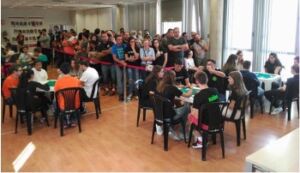 The fallas organise championships of traditional card games, such as bac and truc (dating from 1959-60). After holding different sessions of games, distributed among the different fallas’ homes (llars fallers or casales), according to a calendar organised by the Federation, the Museum becomes the centre of the finals, which are broadcast live on local television.
The fallas organise championships of traditional card games, such as bac and truc (dating from 1959-60). After holding different sessions of games, distributed among the different fallas’ homes (llars fallers or casales), according to a calendar organised by the Federation, the Museum becomes the centre of the finals, which are broadcast live on local television.
The auditorium and the multi-purpose halls are the chosen venue, with a large number of people coming to cheer on their respective fallas during the competition. The number of people who come to compete in this championship of games makes it necessary to organise it by categories, with prizes being distributed according to these categories.
the enhancement of local gastronomy through the Fallas:
Another of the areas in which the fallero collective of Gandia works throughout the year is the gastronomy sector, giving visibility to the typical dishes of Gandia with its powerful position and strength as a community, helping to make them known wherever falleros and falleras circulate and, especially, through their social networks, in which they leave proof of each of the events that take place. These networks are consulted by countless people from all over the world.
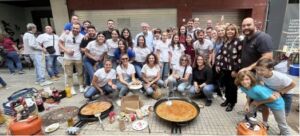 Thus, we find the paella competition, which initially began on certain dates, to later coincide with the celebrations of the 9 d’Octubre, the day of the Comunitat Valenciana, bringing together thousands of falleros and falleras in a huge celebration with the willingness to cook the star dish of the Comunitat, using hundreds of cauldrons in the street and tasting the dish in the company of the collective and with a lively final party.
Thus, we find the paella competition, which initially began on certain dates, to later coincide with the celebrations of the 9 d’Octubre, the day of the Comunitat Valenciana, bringing together thousands of falleros and falleras in a huge celebration with the willingness to cook the star dish of the Comunitat, using hundreds of cauldrons in the street and tasting the dish in the company of the collective and with a lively final party.
The area of the Paseo de las Germanías, the city’s central thoroughfare, fills up with endless tables to accommodate all the people who come to taste this typical dish. However, with time, and in order to accompany the Gandia City Council in the task of promoting the main dish of the local gastronomy, the Fideuà de Gandia, the Fallas decided to substitute the cooking of the paella for the seafood dish, which became the raison d’être of the competition.
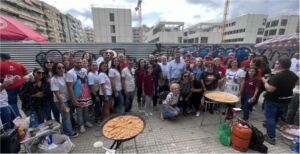 The attendance of falleros and falleras and private people from all over the city and the region has always been significant, but in recent years it has been a first class tourist showcase, with a very important tourist influx that is increasing year after year.
The attendance of falleros and falleras and private people from all over the city and the region has always been significant, but in recent years it has been a first class tourist showcase, with a very important tourist influx that is increasing year after year.
Fideuà de Gandia is the dish par excellence of the city, as it was created here, on the coast of Gandia, and has a specific association in charge of protecting its essence and spreading its goodness, which it does, as well as by other means, through the web page http://fideuadegandia.org/.
According to the website itself, “at the beginning of the 20th century (around 1912-1914), the “arrastre” boats, also known as “de bou”, went out to fish from the Grau de Gandia. These boats would set sail at around four in the morning and return to the port in the early afternoon with the fish to be auctioned at the fish market. This routine did not change throughout the year. Thus, the boats left at night, and while in summer they returned at dusk, in winter they also returned at night. On one of these boats, the “Santa Isabel”, with six sailors on board, it happened that, when it was time to prepare the meal, the cook that day wanted to delight the rest of the crew with his culinary skills, preparing a fantastic seafood paella. To do this, and with great care, he set aside some prawns and langoustines, cut up and chopped up a monkfish, and previously boiled all the fish to make a good broth and thus obtain a fantastic paella to share with his fellow seafarers. In the most traditional way, he fried the prawns and langoustines with the rest of the fish, chopped tomato, garlic, onion and a little paprika in good olive oil. But to his surprise, he realised that there was no rice left on board, only compact noodles (from the spaghetti). The lack of rice was a major setback, so he began to think about how to solve the dilemma and what to do with all those ingredients that were about to caramelise. So it occurred to him to chop up the noodles and add them to the paella as if they were real rice and treat them as such. He let the cooked noodle dry as if it were the normal seafood paella he had set out to make, and set about serving it to his companions. The change worked out well for the cook, and everyone was pleasantly surprised, thanks to the powerful flavour of the invention”.
Today the importance of the dish is crucial for tourism in Gandia, and the Fallas, once again, are committed to everything that has to do with their city and its people, always collaborating with everything that has to do with its riches, in this case, gastronomy. It must be said that since 1974 the Gandia Fideuà Competition has been held, which later became known as the Gandia International Fideuà and Gastronomy Competition, international because of the participation of people from all over the world and gastronomy because the prizes were extended, being awarded not only for the best fideuà, but also for the best dessert made with another traditionally Valencian product: the orange.
fallas poster competition “tomàs femenia”:
Tomás Femenía de Sierra was president of the Junta Local Fallera of Gandia for twelve years, in a very prosperous period, being known by many people, in the city and outside the city and, above all, in the Fallas world of the Comunitat. Since he passed away in 2007, and as a tribute, his name was used to baptise the poster competition in which the poster that will advertise the fallas of the corresponding year is chosen.
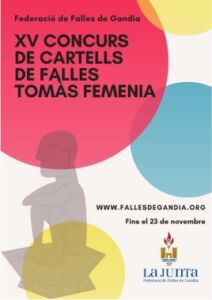 The competition, now in its 15th year, is international in scope and rewards the best design to promote the festival each year. Works are submitted from all over Spain, and sometimes from all over the world, receiving designs, among other countries, from neighbouring Portugal.
The competition, now in its 15th year, is international in scope and rewards the best design to promote the festival each year. Works are submitted from all over Spain, and sometimes from all over the world, receiving designs, among other countries, from neighbouring Portugal.
The competition, as could not be otherwise, has a set of rules to which both the participants and the organisers, the Fallas Federation itself, are subject, together with the jury in charge of choosing the winning entry.
The prize, which is becoming increasingly prestigious, is endowed with an economic amount and the winning poster appears in all the publications and media as an advertisement for the Fallas festival.
fallas concert:
The relationship between Valencian society and band music is inseparable, it is part of the collective identity of our people and, therefore, the Fallas are part of it and vice versa: they feed off each other.
 At the beginning of February, a concert is held in the auditorium of the Museu Faller de Gandia, where representative pieces of Fallas music are played, such as El Fallero, by the composer José Serrano.
At the beginning of February, a concert is held in the auditorium of the Museu Faller de Gandia, where representative pieces of Fallas music are played, such as El Fallero, by the composer José Serrano.
It is a concert open to all citizens and very special, as in addition to these famous compositions, the band plays for the first time the two pasodobles that have been composed for the two Falleras Mayores of the city, which are named after them, and which each year are presented and given to the protagonists themselves at the event. A few years ago, a compact disc was released which includes the different pasodobles dedicated to the Falleras Mayores of the city, the Hymn to Gandia and a Fallas processional march.
the “Tio de la Porra”:
The Tio de la Porra is the most peculiar and characteristic character that Gandia has, well known in the region (in fact, other municipalities have reproduced him in their celebrations), and who takes to the streets to bring the festivities, the Fira i Festes, to the last corner of the city on the day of its beginning, starting the route in the Plaza Mayor and heading towards all the schools of the town, taking children and young people from schools and institutes.
 The appreciation of the character led to the festival being declared an Intangible Asset of Local Relevance by Order 22/2012, of 20 June, of the Regional Ministry of Tourism, Culture and Sport.
The appreciation of the character led to the festival being declared an Intangible Asset of Local Relevance by Order 22/2012, of 20 June, of the Regional Ministry of Tourism, Culture and Sport.
According to the Order: “It is a drum band with a grotesque spirit, which travels the streets and visits the schools of the city on the first day of the fair announcing the beginning of the festivities, as a tribute to the memory and soul of the old comparsas. It seems to have its origins in the Tambor Mayor de la Milicia Nacional of the 19th century, heir to the drums and fifes of the Spanish tercios and the militias of the walled cities. On the first day of the festivities, the bands set off from the Plaza Mayor at 9 a.m. to visit schools and institutions, gathering again at the same place at around 1.30 p.m. to end the event with a pyrotechnic bombardment. The mission or function of this drum band is to sound the reveille and announce the start of the festivities by beating the drums, (…) and to transmit joy to the population in their parade. Since 1934, when they visit the schools, they free the schoolchildren from their homework so that they can enjoy the festive celebration with enthusiasm”.
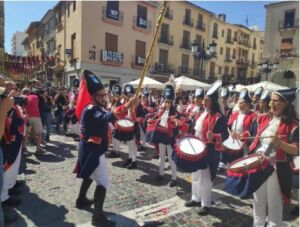 The historian and scholar of the character, J.J. Coll, agrees, stating that it comes from the Drum Major of the National Militia, a transmitter in the 19th century of news from higher institutions to the local administration and popularised in humorous troupes that paraded at the end of the 19th century.
The historian and scholar of the character, J.J. Coll, agrees, stating that it comes from the Drum Major of the National Militia, a transmitter in the 19th century of news from higher institutions to the local administration and popularised in humorous troupes that paraded at the end of the 19th century.
The military aesthetics (Napoleonic uniform) is accompanied by the city’s command staff, as he is in charge of announcing the local festivities all over Gandia, visiting schools and institutes, as we have already mentioned. The city is filled with volunteers, each one with their drums, who in groups announce the beginning of the festivities in the different neighbourhoods while they play a constant percussion score.
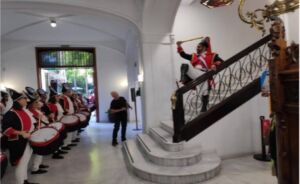 The Federació de Falles participates in this event through a band made up of falleros and falleras of the city, from the twenty-three commissions of the Federation, being the most important of them all, to the point that its captain, embodied by the President of the Federation, carrying the rod of command, becomes the authentic representative of all the bands of the city and the satirical character protagonist of this day of the patron saint’s festivities: the Tio de la Porra (Uncle of the Baton).
The Federació de Falles participates in this event through a band made up of falleros and falleras of the city, from the twenty-three commissions of the Federation, being the most important of them all, to the point that its captain, embodied by the President of the Federation, carrying the rod of command, becomes the authentic representative of all the bands of the city and the satirical character protagonist of this day of the patron saint’s festivities: the Tio de la Porra (Uncle of the Baton).
Above we can see Telmo Gadea Boix, in the year 2019, current President of the Federació de Falles, carrying the stick, that is, the truncheon, leading all the bands in the square, among them, the one made up of falleros and falleras of the city.
At 9:00 in the morning, when all the bands gather in the square, an act is simulated in which the Mayor or Mayoress surrenders to the strength of the Tio de la Porra and gives him his baton, taking over the city for the days of the Fira i Festes, thus announcing that the days of work are behind us, giving way to the hustle and bustle and revelry.
literature and poetry awards:
One more commitment of the Fallas of Gandia, together with the Fallas commission of the neighbouring town of Benirredrà, which is part of the Federació de Falles de Gandia together with the twenty-two commissions of this town (in total, the twenty-three), is aimed at extolling literature and poetry in Valencian, as has already been said in other points and explanations of this report, highlighting now some specific calls for prizes.
On the one hand, we have the Prize for the Best Article in Llibrets de Falla, organised by the Federació de Falles-Junta Local Fallera de Gandia and the Town Council of Benirredrà, which this year 2023 reaches its 15th edition.
The aim of the contest is to find an unpublished article, with an emphasis on originality, written in the Valencian language, that deals with themes related to the fallas, from among those published in the different llibrets for the 2023 financial year throughout the Valencian Community.
There are two prizes: the first prize is 800.00 euros for the winning commission and 200.00 euros for the author; and the second prize is 400.00 euros for the runner-up falla and 100.00 euros for the author of the runner-up article.
On the other hand, there is another literary competition, organised by the Federation and the Fomento de Agricultura, Industria y Comercio (Promotion of Agriculture, Industry and Commerce), with the 21st Joan Climent Poetry Prize, with the aim of promoting poetry published in the llibrets de falla, also written in Valencian.
These two prizes, together with the others related to the llibret, informative and falleras broadcasts, are distributed among the falleras commissions in a literary evening held in the Casa de la Cultura of Gandia.
With regard to the other prizes we are talking about, referring to the llibrets de falla, we have the Lluís Catalá Prize for the best llibrets; the Prize for the Best Overall Literary Quality, sponsored by the CEIC Alfons El Vell (Centre d’Estudis i Investigacions Comarcals), which values the work as a whole; and the Prizes for the covers of the llibrets, which reward originality, technique and good work in terms of design.
photografy award:
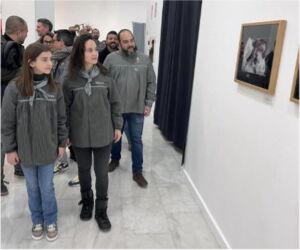 Another aspect of the Fallas of Gandia is photography, as it is responsible for ensuring that the wonderful works created by the Fallas artists, together with all the events organised during the Fallas year, remain for posterity and as a souvenir for those who are here and those who will come.
Another aspect of the Fallas of Gandia is photography, as it is responsible for ensuring that the wonderful works created by the Fallas artists, together with all the events organised during the Fallas year, remain for posterity and as a souvenir for those who are here and those who will come.
For this reason, a few years ago the Federació de Falles de Gandia proposed the creation of this award, which rewards the best images captured by a camera, related to the Fallas theme.
Specifically, three prizes are awarded, for the presentation of which a ceremony is held, presided over by the Falleras Mayores of Gandia, the President of the Federation and the political authorities, as it is sponsored by the City Council of Gandia, in which the following are exhibited
Gandia, in which all the participating works are exhibited, as well as the winning ones, which are distinguished with a poster indicating that they have been awarded.
This is a “young” award, as it has reached its fourth edition in 2023, but it is becoming firmly established in the Fallas universe, with more than a hundred photographs submitted.
An excellent event, with a great reception by the tourists who visit the city, as it allows them to see close up a sample of what the Fallas of Gandia are; in addition, this usually coincides with the exhibition of the Ninot, so that both events contribute to boost the destination.
The Fallas of Gandia declared Intangible Heritage of Humanity by UNESCO:
As a result of all the work carried out over the years, with all the historical baggage and the cultural and festive heritage created, and with the help of the Fallas association network and the citizen community, the Fallas of Gandia were already recognised as being of “Tourist Interest” in 1985; and, subsequently, declared an Asset of Cultural Interest (BIC) in the month of March 2015.
But as the festival has been continuous and its influence on the daily life of the city has been powerful, the Fallas movement became aware of the strength of the entire Gandia community, from public and private entities, through the citizenship, to the already convinced falleros and falleras, which brought as a reward the determination of the Fallas of Gandia, along with those of Valencia, Alzira, Torrent, Cullera and Xativa, as an Intangible Heritage of Humanity Festival.
Between 28 November and 2 December 2016, the eleventh Convention for the Safeguarding of the Intangible Cultural Heritage of UNESCO was held in Addis Ababa, Ethiopia. With the file number 00859, Gandia, along with the rest of the cities promoting the candidacy, opted to obtain such a worthy distinction, which would give prestige and protection to the Fallas Festival, as well as having specific allocations from UNESCO to preserve this heritage. The good news arrived on
30 November 2016, when the Intergovernmental Committee for the Safeguarding of Intangible Cultural Heritage took the long-awaited decision.
The report in the dossier summarises the festival well: “The Fallas festival is a set of practices, rituals, expressions, knowledge and techniques that revolve around the elaboration and destruction through the use of fire of a protagonist element: the falla. The Fallas commission of each neighbourhood makes a falla, a symbolic element around which the whole ritual cycle takes place. It is currently an ephemeral sculpture that is built for months by the artists and artisans of the falleros (painters, sculptors and carpenters) to be burnt as a bonfire on Saint Joseph’s Day”.
A fundamental part of the report focuses on the number of groups, communities and individuals involved in the festival. Thus, on the one hand we have the citizenry, where the falleros and falleras themselves are intrinsically involved, grouping together voluntarily, creating cultural associations with constant activity throughout the year, governed by democratically elected bodies, called Juntas Locales, which today have mostly derived into federations, as it is a more appropriate legal form for the task they carry out.
On the other hand, the Guild of Artisans of Fallas Artists comprises those in charge of making such magnificent artistic works, the fallas; these are the craftsmen and craftswomen who, through acquired and innate knowledge and skills, and through the use of specific techniques, which are passed down from generation to generation, make and erect the fallas monuments.
Pyrotechnicians, on the other hand, are gunpowder professionals who are dedicated to creating and setting up pyrotechnic displays, which are seen in the form of mascletàs and firework displays, the former more commonly during the day, characterised by the roar and vibrational earthquake they cause, and the latter launched at night, to better appreciate the beam of coloured fireworks that are scattered across the black sky.
We also have the music bands, made up of people trained in musical knowledge and in the playing of percussion and wind instruments, with the endorsement of studies at conservatories and music schools. The musical wealth of the Comunitat Valenciana is well known, and it is characterised by the fact that it is the autonomous region with the most music bands in Spain. The Musical Societies form a basic framework within the Valencian society and are a fundamental part of the festival, as they accompany the Fallas commissions in each of their parades, from the day of the presentation of the queens and charges, through the Crida which takes place in February, to each of the days of celebration in March, culminating with the celebration of St. Joseph’s Day.
In this sense, Gandia has one more characteristic, and that is that a musical piece, a pasodoble dedicated to each of them, is composed for each of the representatives of the festival at local level, the Fallera Mayor de Gandia (adult representative) and the Fallera Mayor Infantil de Gandia.
In fact, in 2019, as mentioned above, a very interesting compact disc was released: it includes the eight pasodobles named after the city’s Falleras Mayores, four adults and four children, from 2016 to 2019, as well as the city’s anthem, the Hymn to Gandia, and a processional march with Fallas touches, composed exclusively for the Fallas of Gandia by the composer Hugo Chinesta, which is performed every 19 March in the procession of San José de Gandia.
The Hymn to Gandia was composed in 1922 by Salvador Gea, with lyrics by José María Capsir, on the occasion of the celebration of the Floral Games held that year in the city. In addition to the publication of this record, in collaboration with the town councils of Gandia and Benirredrà, it is worth mentioning that the Federació de Falles de Gandia uses this composition for the moment when the Falleras Mayores de Gandia, adult and child, are called to the stage to occupy the royal throne, creating a magical atmosphere that fully connects with the history of the city, which they represent for a whole year, reaffirming the identity of a group, from its fallas side and as members of the citizens of Gandia, claiming the value of a hymn that is rarely used outside of the fallas. Once again we see how, through the actions of the fallas movement, local traditions flourish and the city’s heritage is recovered, beyond its indisputable fallas transcendence.
We cannot fail to mention the goldsmiths, who create the jewellery worn by falleras and falleras; the costume designers and silk experts, who create the works of art that materialise in the Valencian costumes and fallera costumes; the hairdressers, who do the falleras’ hair for each event; or the florists, who provide the falleras and falleros with their bouquets of flowers for events such as the Ofrena or the Processó.
In addition, we can also mention the writers and poets who, based on the cornerstone of criticism in the Fallas festival, produce writings that often draw on popular wisdom, creating a literature characterised by biting satire of everything that surrounds us, using Valencian as the language of transmission, thus contributing to its use, protection and preservation. Each of the twenty-three fallas of Gandia creates a Llibret, apart from the Foc i Flama published by the Federació de Falles, a book that includes the explanation of the monument together with a large number of articles that go beyond the Fallas festival. This involves economic gain and the involvement in the festival of graphic designers, both for the llibret and for the poster announcing the festival, printers and even proofreaders to obtain an optimum literary work of great quality.
In short, we can sum up this festive event, the Fallas, by quoting once again the dossier presented to UNESCO:
“The Fallas festival is a source of collective creativity and its maintenance allows the continuity of much knowledge, expressions and wisdom that continue to live on thanks to the festival. In this festival, creativity is the element around which all the craft creations involved in its material manifestation revolve: the making of the falla, the design of the jewellery made by the goldsmiths, the choice of designs for the clothing fabrics, the elaboration of the hairstyles, the manufacture of fans and embroidery, the making of large baskets of flowers for the offering, the composition of the conjunction of light and colour in the pyrotechnic manifestations or the manufacture by the luthiers of local instruments.
adhesion to the sicted quality seal and to the gandia tourism experiences product club:
This is another of the issues that shows that the Fallas of Gandia and the city itself go hand in hand in tourism, betting on quality and distinction, each entity from their respective areas.
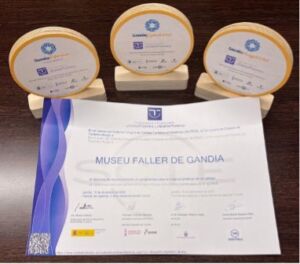 As we know, the Integral System of Spanish Tourist Quality in Destinations, SICTED, is a project to improve the quality of tourist destinations promoted by the Secretary of State for Tourism, with the support of the Spanish Federation of Municipalities and Provinces, encompassing tourist services of up to thirty-six different trades, with the fundamental objective of improving the experience and satisfaction of the tourist.
As we know, the Integral System of Spanish Tourist Quality in Destinations, SICTED, is a project to improve the quality of tourist destinations promoted by the Secretary of State for Tourism, with the support of the Spanish Federation of Municipalities and Provinces, encompassing tourist services of up to thirty-six different trades, with the fundamental objective of improving the experience and satisfaction of the tourist.
Well, the Museu Faller de Gandia has joined this network, which aims to promote and disseminate it, together with the destination that hosts it, the city of Gandia itself, taking advantage of the methodology provided by a comprehensive and permanent system of quality management in the destination of these characteristics. It is also a member of the Gandia Tourism Experiences Product Club, demonstrating, once again, the commitment of the Fallas of Gandia to its city and its tourism.
participation in city events
We have seen throughout the different events the representative importance that the Falleras Mayores de Gandia, the adult and child Falleras Mayores de Gandia, have for the festival. They become a symbol of the fallas of the city in all the events they attend, representing in a neutral way the whole fallas collective of Gandia, even beyond the regional and national borders.
Thus, the Falleras Mayores de Gandia, who are elected each year from among the different commissions that make up the Federació, participate in various events organised by public and private entities in the city, nurturing the amalgam of events that celebrate the Fallas festival, with the positive results of the cultural and touristic dynamisation having an impact on the town itself.
Their presence is used, for example, to advertise tourist sites such as the Palau Ducal dels Borja, a tourist resource of the first magnitude for Gandia; as well as promoting the Archaeological Museum, as we can see in the image of Salva Gregori above.
We also find collaborations of these representative figures in campaigns of the Gandia City Council, related to recycling, Women’s Day or directly linked to the tourist promotion of the destination.
In this way, the Falleras Mayores de Gandia attend every year the International Tourism Fair, FITUR, which is held in Madrid, and which is an important showcase for the different tourist destinations in the world. There they represent the tourism sector of Gandia and the Fallas community itself, in a kind of synergy that feeds off each other. They are also present at the Gandia International Fideuà and Gastronomy Competition, which is held in June, and at the presentation of its poster, this 2023 by Javier Mariscal.
In general, the Falleras Mayores are present in any action that has to do with sales operations of the destination and that have a tourist and commercial projection, due to their representativeness, and also because they often wear their Fallas costumes, which promotes the festival wherever they go, creating circles of interest around them.
But it is not only their representative aspect that should be highlighted, as the Falleras Mayores have for years acquired a vindicating role in causes that are essential for society as a whole, of which the Fallas community is just one more component. Thus, with regard to Women’s Day, the commitment is firm and resolute, from the City Council and the Federation. In this sense, the “8M”, 8th March, of this year 2023 has been organised, in part, by one of the Fallas commissions of the city, the Falla Màrtirs, which is in charge of offering a solidarity meal in its commemoration, and which will be attended, of course, by the Fallas Majors of the city to give notoriety.
Another of the initiatives in which the fallas are collaborating, at city level, focuses on the search for sustainability and recycling. The Federation, together with the entity Ecovidrio, develops every year a campaign under the name “la Plantà del vidrio”, which aims to raise awareness and raise awareness about recycling in the Fallas festival, aimed at the group, in particular and also to its visitors, as there are many tourists who come to Gandia in the Fallas week of March and aims to promote the care and cleanliness of the municipality, as well as the commitment to glass recycling in the Fallas area, in each of the festive houses, during the celebrations.
All this without counting the invitation of the Falleras Mayores to countless official events in which, with their presence, contribute to enhance and extol the institutionalization of the festival of the Fallas of Gandia.
And, without a doubt, one of the greatest exponents of the Fallas are the fallera and valenciana costumes, worn by the different falleras and falleros of the commissions, whose greatest example and centre of attention are the Falleras Mayores of Gandia, which have a clear projection in the diffusion of the festival, due to the richness of their materials and the peculiar technique for their manufacture, They have become a point of reference and a real attraction for tourists and visitors, so that in many events organised by public and private entities in the city, with a tourist vocation, the highest representatives of the festival are invited to wear their traditional costumes, in order to cause a greater impact.
The Falleras Mayores de Gandia 2023, in their traditional dress, offering their support to the AVE Madrid-València campaign, to promote our city and the brand “Gandia en Falles”, which sponsored the covers that covered the headrests of the train seats, on 7 March.
Among the private initiatives attended by these representatives, we find everything from popular races or walks, to awards from national, regional and local radio stations, such as Cadena SER, to collaborations with other “sister” festivals in the city, such as Easter Week in Gandia (already declared a Festival of National Tourist Interest), as we can see in the images below, taken from the Facebook page of the Federació de Falles de Gandia.
the solidarity aspect of the fallas in gandia:
We have already seen how the figure of the Falleras Mayores de Gandia are fundamental to promote and spread the Fallas festival everywhere they go, in the name and on behalf of all the falleros and falleras of the city, but it is also that they themselves embody and champion causes that highlight the solidarity aspect of the festival, building a favourable and positive image of it, which transcends to the tourist and visitor.
We find collaborations with the entity Alma de Acero, which seeks to help the children of the Primary Care Centre of the Mancomunidad de Municipios de la Safor.
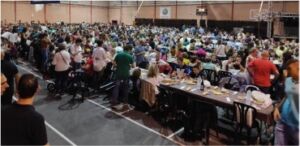 They also work with the Spanish Red Cross and other charities, both in the city and in the region, seeking funds for them, collecting clothes and basic foodstuffs, as when they collaborate with the Gandia soup kitchen, or lending their support and visibility to campaigns in favour of the fight against various diseases, such as ALS or cancer. This can be seen in the images below, obtained from the Facebook profile of the Federació de Falles, “Falles de Gandia”.
They also work with the Spanish Red Cross and other charities, both in the city and in the region, seeking funds for them, collecting clothes and basic foodstuffs, as when they collaborate with the Gandia soup kitchen, or lending their support and visibility to campaigns in favour of the fight against various diseases, such as ALS or cancer. This can be seen in the images below, obtained from the Facebook profile of the Federació de Falles, “Falles de Gandia”.
A highlight is the collection of non-perishable food during the Sopar de Germanor, all of which is donated to the San Francisco De Asís Shelter Centre in the neighbouring town of Palma de Gandia.
Not forgetting the collaboration of each fallera commission with charitable organisations and associations, which is instrumented through their annual actions, such as when they buy from Espurna (a foundation dedicated to the comprehensive care of people with intellectual disabilities) the gifts and presents that are given to the aforementioned Fallers d’Honor.
Or the monetary fundraising campaign in favour of the Preventorio Infantil de Nuestra Señora del Amparo de Real de Gandia, which is a school and residence for children between the ages of three and thirteen. The school is subsidised by the Generalitat Valenciana, but the part of the residence, the Preventorio, receives no official aid. Hence, many campaigns are launched to collaborate with this entity, which takes in minors who, for various reasons, cannot live at home with their families.
And here are the fallas, once again, to collaborate in this important work, participating in a radio campaign that Cadena SER-Radio Gandia has been organising for many years, which is attended by the Falleras Mayores de Gandia to encourage listeners to contribute. In fact, for each fallero or fallera who calls the radio station making a donation, the Federation contributes one euro more to the pot finally collected, so that important figures are achieved in the three days of operation.
Another unforgettable solidarity initiative was the one carried out in 2016, under the name “Moños rosas”. The falleras, after the celebration of the fallas in the week of March, usually cut their hair to make it healthier, after so many interventions on their hair and applications of products to maintain the fallera buns, so, taking advantage of this gesture, they wanted to give it a solidarity aspect by donating this excess hair, which is thrown away on normal occasions, to make wigs that would then be used by other people with cancer.
Thus, a “pink box” was handed out in each fallero’s casal to collect the excess hair of the falleras, which was donated to the following organisations
“Flocs Solidaris”, an association dedicated to making personalised oncological wigs; “ASPANION”, an association of mothers and fathers of children with cancer in the Valencian Community; and “La Vida es Bella”, an association of women affected by breast cancer.
On the other hand, each year, a Fallera Mayor of Gandia who has held the position in previous years is chosen to organise a solidarity meal, in which money and food is collected, with the proceeds going to an association or entity chosen for the purpose on each occasion, which is carried out with the help of the members of their Corts of Honour.
Finally, and without being able to list each and every one of the solidarity initiatives carried out in the Fallas of Gandia, we must refer to the cession of the Museu Faller as a vaccination centre for the Generalitat Valenciana, in times of the health crisis caused by the Covid-19 pandemic, using this large space to carry out an operation of such magnitude.
COMMITMENT TO THE LGTBI+ COMMUNITY:
We have already seen how the Fallas of Gandia take part in city or institutional events, which gives them more prominence, due to the loudspeaker that spreading the news among a large group, such as the fallero. We have explained this with regard to solidarity causes, acts related to the fight against illnesses, or to extolling and projecting feminism and the fight against male violence.
And another concrete example of help and commitment to groups mistreated by society can be found in the announcement of the awards for the best LGTBI+ themed scenes from among the different Fallas monuments of Gandia and Benirredrà, that is, from among the commissions belonging to the Federation of Fallas of Gandia.
This award is promoted by the Department of Equality, Diversity and Inclusive Policies of Gandia City Council, which organises a jury that visits the participating commissions in each edition; an award that is very well received by them.
In general terms, the aim is to highlight scenes with messages in favour of affective-sexual, gender and family diversity, which contribute to giving visibility to diversity, to the LGTBI+ collective.
PRIZES FOR THE BEST ECOLOGICAL SCENES IN THE FALLAS:
The Fallas Federation of Gandia and all the commissions that make it up are aware of the need to take care of the environment, as something innate to human beings, as a way of life and a way of proceeding on a daily basis. For this reason, an interesting initiative, promoted by the Gandia City Council, is to choose the three best ecological scenes located in the Fallas monuments of each year.
This is an interesting way of committing to sustainability and making the Fallas community aware of the need to hold festivals that meet the needs of the present without compromising the capacity of future generations, guaranteeing a balance between economic growth, care for the environment and social well-being.

